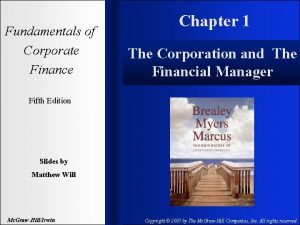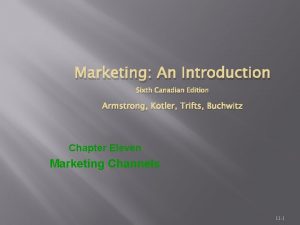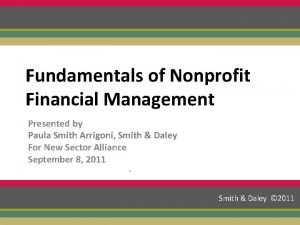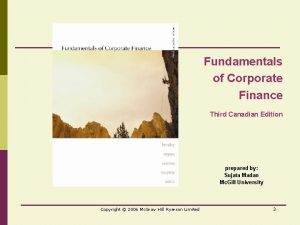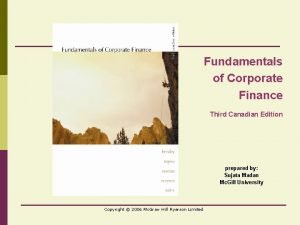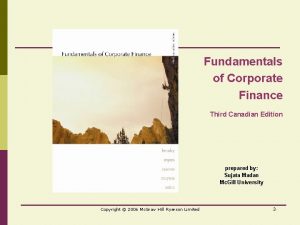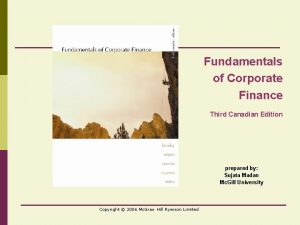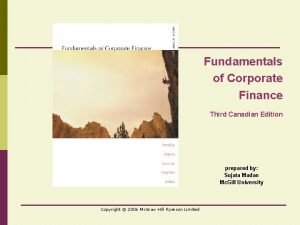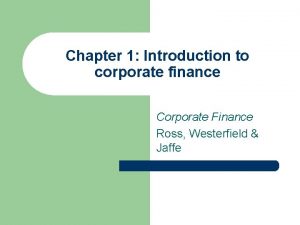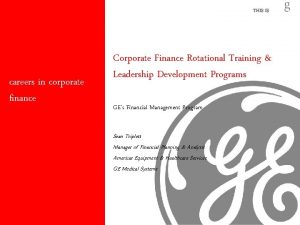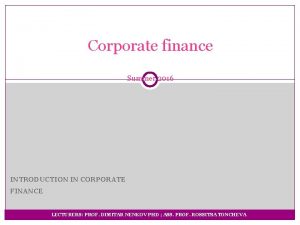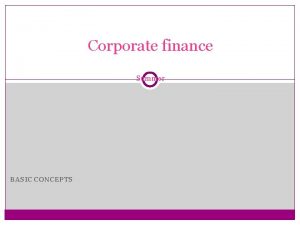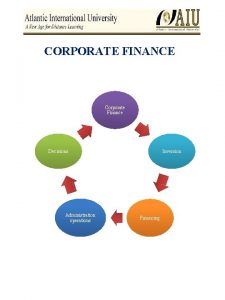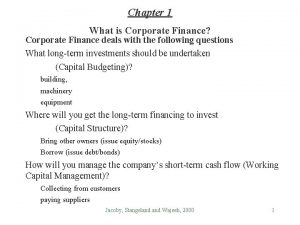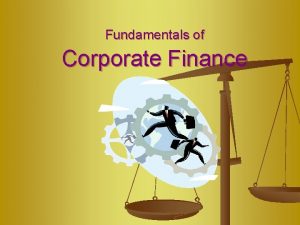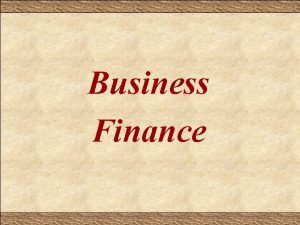Fundamentals of Corporate Finance Third Canadian Edition prepared






























- Slides: 30

Fundamentals of Corporate Finance Third Canadian Edition prepared by: Sujata Madan Mc. Gill University Copyright © 2006 Mc. Graw Hill Ryerson Limited

Chapter 19 Working Capital Management and Short Term Planning n Working Capital n Links Between Long-Term and Short-Term Financing n Tracing Changes in Cash and Working Capital n Cash Budgeting n A Short-Term Financing Plan n Sources of Short-Term Financing n The Cost of Bank Loans Copyright © 2006 Mc. Graw Hill Ryerson Limited 2

Working Capital n Terminology w Net Working Capital: Current assets minus current liabilities. Often called working capital. w Cash Conversion Cycle: Period between firm’s payment for materials and collection on its sales. w Carrying Costs: Costs of maintaining current assets, including opportunity cost of capital. w Shortage Costs: Costs incurred from shortages in current assets. Copyright © 2006 Mc. Graw Hill Ryerson Limited 3

Working Capital n A Simple Cycle of Operations: CASH RECEIVABLES RAW MATERIALS INVENTORY FINISHED GOODS INVENTORY Copyright © 2006 Mc. Graw Hill Ryerson Limited 4

Working Capital n The Cash Conversion Cycle Average Inventory Period = Annual Cost of Goods Sold/365 Accounts Receivable Period = Accounts Payable Period = Average A/R Annual Sales/365 Average Accounts Payable Annual Cost of Goods Sold/365 Copyright © 2006 Mc. Graw Hill Ryerson Limited 5

Working Capital n Example: Canadian non-financial enterprises 1. How long on average does it take Canadian non-financial firms to produce and sell their product? 2. How long does it take to collect bills? 3. How long does it take to pay bills? 4. What is the cash conversion cycle? Copyright © 2006 Mc. Graw Hill Ryerson Limited 6

Working Capital n Example: Canadian non-financial enterprises Inventory Period = = = Average Inventory Annual Cost of Goods Sold/365 (218, 896+222, 513)/2 2, 104, 620/365 38. 3 days Copyright © 2006 Mc. Graw Hill Ryerson Limited 7

Working Capital n Example: Canadian non-financial enterprises Receivables Period = = = Average Accounts Receivable Annual Sales/365 (264, 622+264, 733)/2 2, 144, 891/365 45. 1 days Copyright © 2006 Mc. Graw Hill Ryerson Limited 8

Working Capital n Example: Canadian non-financial enterprises Payables Period = = = Average Accounts Payable Annual Cost of Goods Sold/365 (318, 058+325, 240)/2 2, 104, 620/365 55. 8 days Copyright © 2006 Mc. Graw Hill Ryerson Limited 9

Working Capital n Example: Canadian non-financial enterprises Cash Conversion Cycle = Inventory Period + Receivables Period - Accounts Payable Period = 38. 3 + 45. 1 - 55. 8 = 27. 6 days Copyright © 2006 Mc. Graw Hill Ryerson Limited 10

Working Capital n. The Working Capital Trade-Off w Working capital can be managed. w There are costs and benefits associated with the firm’s investment in working capital. § § w Carrying costs Shortage costs An important job of the financial manager is to find the level of current assets that minimizes the sum of carrying costs and shortage costs. Copyright © 2006 Mc. Graw Hill Ryerson Limited 11

Links Between Long-Term and Short-Term Financing n Total Capital Requirement Trend Copyright © 2006 Mc. Graw Hill Ryerson Limited 12

Tracing Changes in Cash and Working Capital n Example: Dynamic Mattress Company Copyright © 2006 Mc. Graw Hill Ryerson Limited 13

Tracing Changes in Cash and Working Capital n Example: Dynamic Mattress Company Copyright © 2006 Mc. Graw Hill Ryerson Limited 14

Cash Budgeting n Creating a Cash Budget 1. Forecast the sources of cash. 2. Forecast the uses of cash. 3. Calculate whether the firm is facing a cash shortage or surplus. n The financial plan then sets out a strategy for investing a cash surplus or financing a deficit. Copyright © 2006 Mc. Graw Hill Ryerson Limited 15

Cash Budgeting n Example: Dynamic Mattress w The managers have forecasted that quarterly sales for 2002 will be: Quarter Sales ($ millions) w 1 st 2 nd 3 rd 4 th 87. 5 78. 5 116 131 Assume 20% of each quarter’s sales are collected in the next quarter. Copyright © 2006 Mc. Graw Hill Ryerson Limited 16

Cash Budgeting n Example: Dynamic Mattress w DMC’s collections on its sales would be as follows: Quarter 1 st 2 nd 3 rd 4 th Sales ($ millions) 80% collected now: 87. 5 70. 0 78. 5 62. 8 116 92. 8 131 104. 8 20% in next period: 15. 0 17. 5 15. 7 23. 2 Copyright © 2006 Mc. Graw Hill Ryerson Limited 17

Cash Budgeting n Example: Dynamic Mattress w Dynamic Mattress’s collections on accounts receivables: Copyright © 2006 Mc. Graw Hill Ryerson Limited 18

Cash Budgeting n Example: Dynamic Mattress w Dynamic Mattress’s forecast uses of cash: § § Payment of accounts payable Labor, administration, and other expenses Capital expenditures Taxes, interest, and dividend payments Copyright © 2006 Mc. Graw Hill Ryerson Limited 19

Cash Budgeting n Example: Dynamic Mattress w Dynamic Mattress’s cash budget: Copyright © 2006 Mc. Graw Hill Ryerson Limited 20

Cash Budgeting n Example: Dynamic Mattress w Dynamic Mattress’s short-term financing requirement: Copyright © 2006 Mc. Graw Hill Ryerson Limited 21

A Short-Term Financing Plan n Example: Dynamic Mattress Copyright © 2006 Mc. Graw Hill Ryerson Limited 22

A Short-Term Financing Plan n Evaluating the Plan w Short-term financial plans are developed by trial and error. w You lay out one plan, and iterate on it with different assumptions about the financing and investment alternatives. w You continue until you can think of no further improvements. Copyright © 2006 Mc. Graw Hill Ryerson Limited 23

Sources of Short-Term Financing n Alternative Sources of Financing w Bank Loans § § A bank loan is an unsecured loan. A line of credit is an agreement by a bank that a company may borrow at any time up to an established limit. Copyright © 2006 Mc. Graw Hill Ryerson Limited 24

Sources of Short-Term Financing n Alternative Sources of Financing w Commercial Paper § § Commercial paper is a short-term unsecured note issued by a firm. Commercial paper is issued by large, wellknown companies which regularly need to borrow large amounts of cash. Copyright © 2006 Mc. Graw Hill Ryerson Limited 25

Sources of Short-Term Financing n Alternative Sources of Financing w Banker’s Acceptance § § A banker’s acceptance is a firm’s time draft that has been accepted by a bank. This means the bank guarantees payment of the amount stated on the draft when it matures. Copyright © 2006 Mc. Graw Hill Ryerson Limited 26

Sources of Short-Term Financing n. Alternative w Sources of Financing Secured Loans § Sometimes a company will offer assets as security. q. A/R financing q. Inventory financing Copyright © 2006 Mc. Graw Hill Ryerson Limited 27

The Cost of Bank Loans n Comparing Rates Simple Interest = Amount of Loan x Annual Interest Rate Number of Periods in the Year Effective Annual Rate EAR = ( Quoted Annual Interest Rate 1+ m Copyright © 2006 Mc. Graw Hill Ryerson Limited m ) -1 28

Summary of Chapter 19 w Short-term financial planning is concerned with the management of the firm’s short-term or current assets. w The difference between current assets and current liabilities is called net working capital. w The cash conversion cycle is the length of time between the firm’s payment for materials and the date it gets paid by its customers. Copyright © 2006 Mc. Graw Hill Ryerson Limited 29

Summary of Chapter 19 w A firm’s short-term financial planning is determined by the amount of long-term capital it raises. § w The starting point for short-term financial planning is forecasting the sources and uses of cash. Most firms take a middle of the road approach, investing cash surpluses during part of the year and borrowing during the rest of the year. Copyright © 2006 Mc. Graw Hill Ryerson Limited 30
 Fundamentals of corporate finance canadian edition
Fundamentals of corporate finance canadian edition Fundamentals of corporate finance, third canadian edition
Fundamentals of corporate finance, third canadian edition Fundamentals of corporate finance fifth edition
Fundamentals of corporate finance fifth edition Fundamentals of corporate finance 6th edition
Fundamentals of corporate finance 6th edition Fundamentals of corporate finance chapter 6 solutions
Fundamentals of corporate finance chapter 6 solutions Fundamentals of corporate finance, chapter 1
Fundamentals of corporate finance, chapter 1 Fundamentals of corporate finance, chapter 1
Fundamentals of corporate finance, chapter 1 Objectives of corporate governance
Objectives of corporate governance Corporate finance tenth edition
Corporate finance tenth edition Corporate finance tenth edition
Corporate finance tenth edition Corporate finance tenth edition
Corporate finance tenth edition Corporate finance tenth edition
Corporate finance tenth edition Corporate finance tenth edition
Corporate finance tenth edition Marketing an introduction 6th canadian edition
Marketing an introduction 6th canadian edition Accounting principles second canadian edition
Accounting principles second canadian edition Accounting principles second canadian edition
Accounting principles second canadian edition Accounting principles second canadian edition
Accounting principles second canadian edition Accounting principles second canadian edition
Accounting principles second canadian edition Gj mount classification of dental caries
Gj mount classification of dental caries Caries profunda definition
Caries profunda definition Finance fundamentals for nonprofits
Finance fundamentals for nonprofits Real estate finance fundamentals
Real estate finance fundamentals Fundamentals of information systems 9th edition
Fundamentals of information systems 9th edition Fundamentals of information systems 9th edition
Fundamentals of information systems 9th edition Fluid mechanics fundamentals and applications
Fluid mechanics fundamentals and applications Thomas l floyd digital fundamentals 10th edition
Thomas l floyd digital fundamentals 10th edition Machining fundamentals 10th edition
Machining fundamentals 10th edition Fundamentals of organizational communication
Fundamentals of organizational communication Fundamentals of organizational communication 9th edition
Fundamentals of organizational communication 9th edition Digital fundamentals floyd 10th edition
Digital fundamentals floyd 10th edition Digital fundamentals floyd ppt
Digital fundamentals floyd ppt






